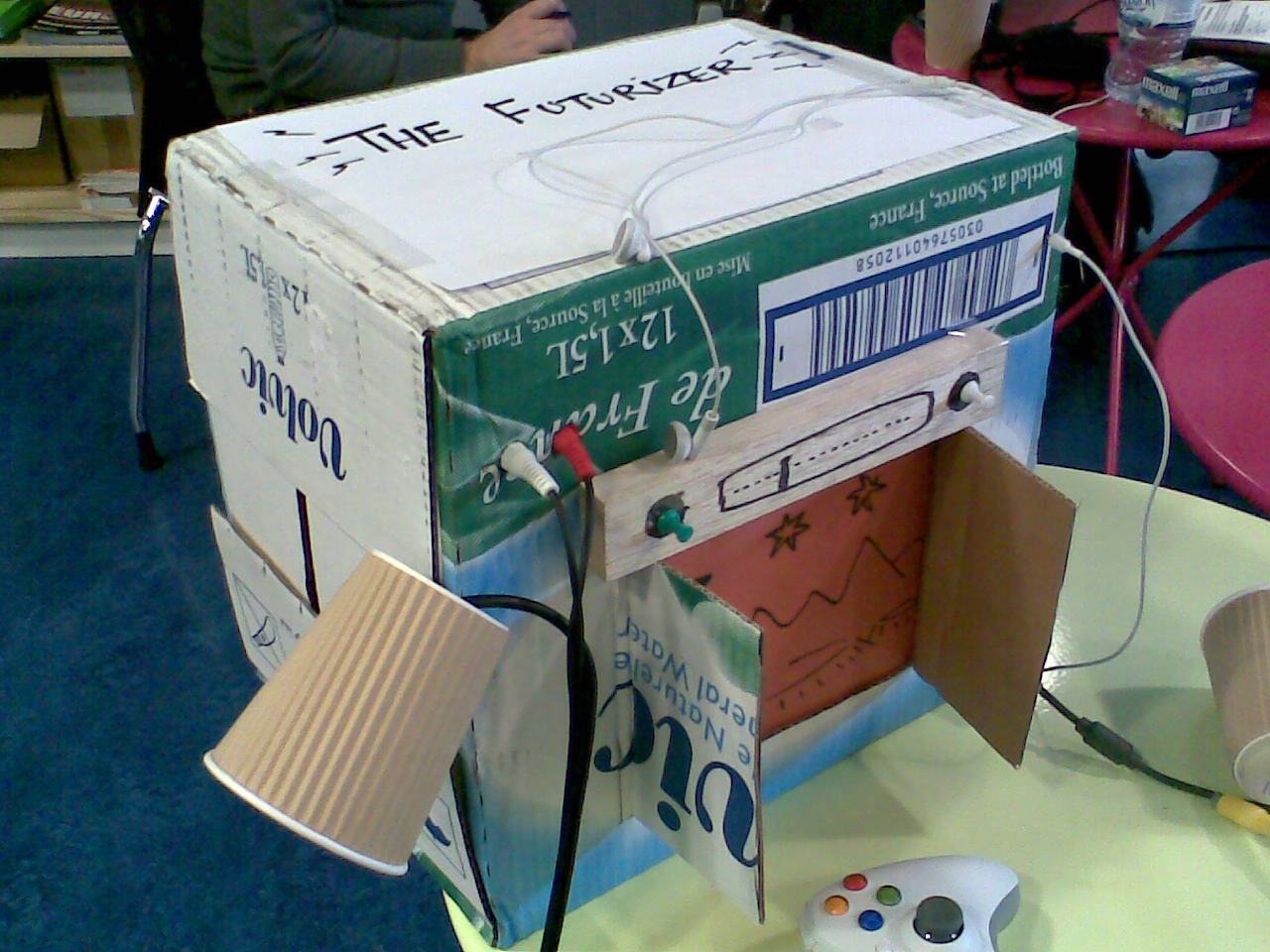
The picture is of a Futurizer, based on the kinds of contraption I built as a child from cardboard, balsa wood and string which allowed me to communicate with other planets and centuries. It was reconstructed by a group of us at a conference on Transliteracy at the Institute of Creative Technologies at De Montfort University, organised by PART. The aim of the day was to try to make some transliterate objects and in so doing consider if such things can, could or should exist. We had an enjoyable if inconclusive time grappling with this.
Plug headphones into an iPod or XBox and you will be able to listen to one of a large but finite range of sounds. Plug headphones into a cardboard box and you can (not) hear anything you can possibly imagine. Travelling back through the years to my childhood, these machines allowed me to think across time and space, out of the (cardboard) box. They were also a means of engaging with the TV I loved, in a bygone era when no adult expressed any interest in the way I read my TV21 comic or consumed Thunderbirds and The Man From Uncle.
Unlike those friends who screwed together bits of meccanno to build working bridges, or fiddled with circuit boards until bulbs lit up, my games were all about interfaces.
I never worried for a moment about how these things might actually work. Now a lot of inventiveness is once again going into cutting and sticking, playing with FaceBook applications and YouTube clips like we used Corn Flake packets and sticky-backed plastic. Isn’t it great, living here in the future?
By the end of the day the Futurizer had been photographed and uploaded to Second Life. a fitting place for it to end up really: transmogrified, transliterated, futurized.
Category Archives: transliteracy
playing with words
In London next week our first if:book:group brings together a small group of people from the worlds of new media, literature, theatre and playground design to discuss Narrative, Interactivity and Play.
New media fiction has been described as writing in colour rather than black and white. It’s a winning description, but they say radio has better pictures than TV, and the same may still be true of a good story in print versus a slow and clunky multimedia experiment with swimming text and sludgy soundtrack. But things are changing fast.
A funky new reader device – like the pinchable, strokeable iPhone perhaps – and, more importantly, a truly riveting, essentially digital masterpiece could quickly bring a mass readership to this kind of literature.
My sister and I have just bought my mother a widescreen tv. Mum felt I was trying to foist a monstrosity on her. Why would she want some huge, ugly screen dominating her sitting room, what was wrong with the (tiny) telly she already owned? After sleepless nights worrying she’d hate it, in the event, her conversion took less than five minutes. A schools’ programme about the Nile won her round. The quality of sound and image is outstanding; instead of getting an illustrated talk about a place, this screen transports her there.
The boundaries between page and screen, inside and outside, imagination and reality are shifting around us. We are fumbling towards new ways to make and publish fictions online. Interaction needs to be more than the multiple choice options for what’s next. Readers want to inhabit a good book, not be pressured into helping to write it. This was a point made by Guy Parsons, one of the team involved in the PerplexCity game, at a seminar on 27th September on the Reader/Writer Mash Up organised by the Reading Agency and Creative Partnerships in London
Earlier that month an ‘Unconference’ at the Institute of Creative Technologies, De Montfort University, raised the question of what skills we need to make and read multi-platform narratives. Are the channel hopping, multi-tasking children of today exhibiting attention deficit or vital skills in transliteracy?
Instead of visiting one site a time, now we go to our screens and mix up for ourselves a cocktail of activity: emailing friends, checking news feeds, googling for information and surfing fpr pleasure, writing our own documents while listening to music, taking a break to watch a youtube or two… This is the wwwreader in creative control.
Snug & Outdoor is a playground design company I work with which has developed a kit of abstract shapes that children themselves can arrange as they wish to reshape the schoolyard into a changing playscape. The Snug Kit, launched this November, has grown out of observation of how children actually play; they don’t enact complete adventures but drop in and out of narrative threads – walk along a wall and you’re escaping across a chasm; clamber up a tree and you’re creeping up on an enemy; enter an enclosed space and it becomes a homestead where imaginary meals are cooked and served.
So if children so effortlessly switch narratives in their play, how come I still get hooked on formulaic TV and film, over and over and over drawn in by the need to find out whodunnit, whether boy gets girl or goody escapes baddy, when we all know what’s bound to happen and have no reason to care if it didn’t? Can we overcome our addiction to conclusions and find more compelling ways to play with those seven core stories of which all fiction is made?
To be continued…
